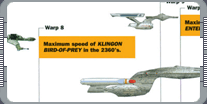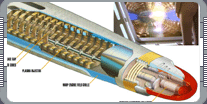
Warp Engines
Starfleet vessels use warp engines to travel at velocities up to 3,000 times the speed of light.
 A warp engine works by distorting the space-time continuum, pushing a vessel into subspace and thereby reducing
its apparent mass. Once its effective mass has been reduced, a vessel can overcome the restrictions imposed by
Einstein's general theory of relativity (E=mc2 or energy=mass multipled by the speed of light
squared) and accelerate to faster than light speed (c). Following the model that was established by Zefram
Cochrane, Federation vessels' warp engines accomplish the transition into subspace by using a matter-antimatter
reaction to generate a series of warp fields that exert force against one another. The matter-antimatter
reaction takes place in the warp core; the warp fields are generated in the nacelles. A vessel's warp engine
relies on three distinct elements; a matter-antimatter reaction assembly (commonly known as the warp core),
power transfer conduits, and warp nacelles. The warp core not only produces power for the ship's propulsion
systems, but acts as the vessel's main power generator, supplying energy to all the ship's systems.
A warp engine works by distorting the space-time continuum, pushing a vessel into subspace and thereby reducing
its apparent mass. Once its effective mass has been reduced, a vessel can overcome the restrictions imposed by
Einstein's general theory of relativity (E=mc2 or energy=mass multipled by the speed of light
squared) and accelerate to faster than light speed (c). Following the model that was established by Zefram
Cochrane, Federation vessels' warp engines accomplish the transition into subspace by using a matter-antimatter
reaction to generate a series of warp fields that exert force against one another. The matter-antimatter
reaction takes place in the warp core; the warp fields are generated in the nacelles. A vessel's warp engine
relies on three distinct elements; a matter-antimatter reaction assembly (commonly known as the warp core),
power transfer conduits, and warp nacelles. The warp core not only produces power for the ship's propulsion
systems, but acts as the vessel's main power generator, supplying energy to all the ship's systems.
In the simplest terms, the warp core works by burning deuterium to create gases, which are then forced together
with antimatter in the form of antihydrogen. The reaction is controlled by dilithium crystals to create a
plasma stream that is split in two and routed to the warp nacelles. In the nacelles, the plasma is used to
energize the warp field coils, which are made of verterium cortenide. When this substance is energized, it
causes the energy frequencies in the plasma to shift into subspace, creating warp fields. The nacelles combine
to create a multilayered warp field that surrounds the ship. Starships cross the light-speed barrier by
 manipulating this field. The field coils in the nacelles are arranged in rows so that they generate separate
layers of warp field energy which nest against one another, with each layer exerting a controlled amount of
force against its next outermost neighbor. The cumulative force of the nested fields drives the vehicle forward.
The effect is known as asymmetrical peristalitc field manipulation (APFM).
manipulating this field. The field coils in the nacelles are arranged in rows so that they generate separate
layers of warp field energy which nest against one another, with each layer exerting a controlled amount of
force against its next outermost neighbor. The cumulative force of the nested fields drives the vehicle forward.
The effect is known as asymmetrical peristalitc field manipulation (APFM).
Warp fields are measured according to the amount of subspace stress they generate; field stresses are measured
in cochranes. Fields that are below warp 1 are measured in units a thousands times smaller called
millicochranes. A field of one cochrane or greater is often referred to as a warp field. The warp scale has
been drawn up so that warp 10 is infinite velocity; in theory any vessel traveling at this speed would occupy
every point in the universe at once. As a warp field approaches the stress needed to achieve this speed, the
power requirements rise dramatically and the warp drive efficiency drops. Speeds below warp 10 are plotted on
an exponential curve. Thus, whereas a ship traveling at warp 1 is traveling at c, a ship moving at warp 4 is
traveling at 102c, and a ship flying at warp 9 is traveling at 1516c. The curve becomes extremely steep in the
warp 9.9 range, and enormous increases in speed are needed to progress from warp 9.91 to warp 9.92. In a few
rare instanced starships have traveled incredible, even intergalactic, distances in a matter of seconds. These
journeys probably took place in the warp 9.9999999996 range, but Federation science cannot measure speeds
approaching this range. Crossing the warp barrier requires a disproportionate amount of energy. Once the warp
threshold has been passed, the power needed to maintain the field lessens.
As the field layers expand from the nacelles they experience a rapid force coupling and decoupling; they
simultaneosuly transfer energy and separate from the previous layer at velocities between 0.5c and 0.9c. As
the fields force couple, the radiated energy makes the transition into subspace, effectively reducing the mass
 of the spacecraft. This unbalances Einstein's equation and enables a vessel to overcome the restrictions of
general relativity; because the ship's mass has been reduced, enough energy can now be generated to accelerate
beyond the speed of light. The warp field coils are energized in sequentual order, moving from the front to the
back. The more often the coils are energized, the more fields they generate, and the higher the warp speed.
of the spacecraft. This unbalances Einstein's equation and enables a vessel to overcome the restrictions of
general relativity; because the ship's mass has been reduced, enough energy can now be generated to accelerate
beyond the speed of light. The warp field coils are energized in sequentual order, moving from the front to the
back. The more often the coils are energized, the more fields they generate, and the higher the warp speed.
Most vessels use two warp nacelles and maneuver in space by creating slight imbalances in the warp field
geometry produced by each nacelle. The symmetrical warp nacelles help to create this imbalance if one or the
other is damaged, the operation of a single warp nacelle can literally tear a ship apart. Nacelles are usually
located near the rear of a ship, connected to the engineering hull by long, sweeping support pylons that keep
the potentially dangerous warp fields away from the inhabited areas of the ship. The shape of the hull has been
designed to help it achieve warp speeds and to influence the geometry of the field itself.
Warp nacelles are constructed from tritanium, duranium, cobalt cortenide, verterium cortenide, and
tungsten-cobalt-magnesium - and assembled with gamma-welding manufacturing techniques 2.5 meters thick. The
pressures exerted on the nacelles are extreme, and is countered by three levels of cobalt cortenide that line
the structure's inner hulls. The power contained within nacelles are so potent that they can be extremely
dangerous if they malfunctioned, so safety features are incorporated that allow them to be jettisoned in an
emergency; explosive structural latches are fired, driving the nacelles away from the ship at a rate of 30 meters
 per second. New features on the Sovereign-class includes
emergency plasma purge vents in the nacelle support pylons. The vents trace the length of the pylons, and are
adjacent to the power transfer conduits that supply plasma to the warp field coils. This ventilation system
provides engineers with another safety buffer by allowing them to bleed off heated plasma before it reaches the
warp field coils, obviating in some circumstances the need to shut down systems or eject the warp core.
per second. New features on the Sovereign-class includes
emergency plasma purge vents in the nacelle support pylons. The vents trace the length of the pylons, and are
adjacent to the power transfer conduits that supply plasma to the warp field coils. This ventilation system
provides engineers with another safety buffer by allowing them to bleed off heated plasma before it reaches the
warp field coils, obviating in some circumstances the need to shut down systems or eject the warp core.
Inside the nacelles, the warp plasma generated by the warp core is turned into energy that propels a ship. In
emergencies, when plasma is unable to reach the warp nacelles the Bussard ramscoop assembly at the front of each
nacelle is able to draw in low-grade galactic matter and use this as an energy source instead. There are two
major components to warp nacelles: the plasma injection system, and the warp field coils. A plasma injection
system is located at the terminus of each of the power transfer conduits that carry plasma from engineering,
where it is generated, to the warp field coils, where it is turned into energy. There is one injector for each
of the warp field coils.
Each pair is fired in variable sequences, allowing for the permutations to be specified for different types of
flight function. The open-close cycle can vary between 25 and 50 nanoseconds; low warp factors require the
injectors to be fired at low frequencies, remaining open for short periods, higher warp speeds require higher
frenquencies and longer openings. The longest safe cycle for which an injector can be open is 53 nanoseconds.
The warp field coils generates the actual warp field that propels a ship, by forming an intense, multi-layered
effect that surrounds the starship. The ship is propelled beyond the speed of light by the manipulation of the
shape of this field. On the Galaxy-class each nacelle contains 18
warp field coils and 26 sets on the Sovereign-class which, combined, account for almost a quarter of the weight
for the entire starship.
 The Sovereign-class nacelle design includes some new features inspired by Starfleet's encounters with the Borg
and the Dominion. Most the of the redesigns are the result of development in areas of high-frequency subspace
modulation, ship profiling studies, and the introduction of variable-geometry pylons. While most Federation
ships cruise in the warp 6 range, the larger, more efficient warp nacelles, coupled with a decrease in the
ship's internal volume, yield a cruising velocity of warp 8, with a high warp velocity of 9.95 - about 5,000
times the speed of light. The Sovereign-class ships can travel at high speeds with impunity, as the warp drive
system no longer creates the warp field effect - dramatically highlighted by Dr. Serova in 2370 - that weakens
the subspace continuum. While technological advances continue to push the upper limits of the warp speed scale,
the increasing energy requirements are so great that significant improvements appear unlikely. It seems
greater speeds will require different technologies.
The Sovereign-class nacelle design includes some new features inspired by Starfleet's encounters with the Borg
and the Dominion. Most the of the redesigns are the result of development in areas of high-frequency subspace
modulation, ship profiling studies, and the introduction of variable-geometry pylons. While most Federation
ships cruise in the warp 6 range, the larger, more efficient warp nacelles, coupled with a decrease in the
ship's internal volume, yield a cruising velocity of warp 8, with a high warp velocity of 9.95 - about 5,000
times the speed of light. The Sovereign-class ships can travel at high speeds with impunity, as the warp drive
system no longer creates the warp field effect - dramatically highlighted by Dr. Serova in 2370 - that weakens
the subspace continuum. While technological advances continue to push the upper limits of the warp speed scale,
the increasing energy requirements are so great that significant improvements appear unlikely. It seems
greater speeds will require different technologies.
|
|
"PROPULSION SYSTEMS" - JUNE 2000 ISSUE 14 STAR TREK: THE MAGAZINE COPYRIGHT OF PARAMOUNT PICTURES.
|